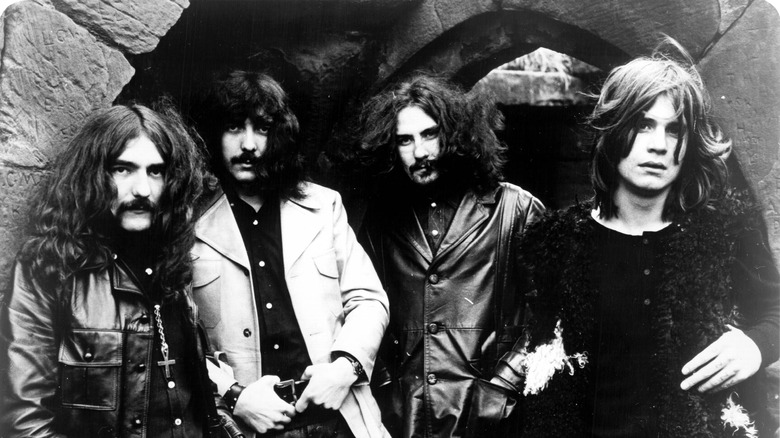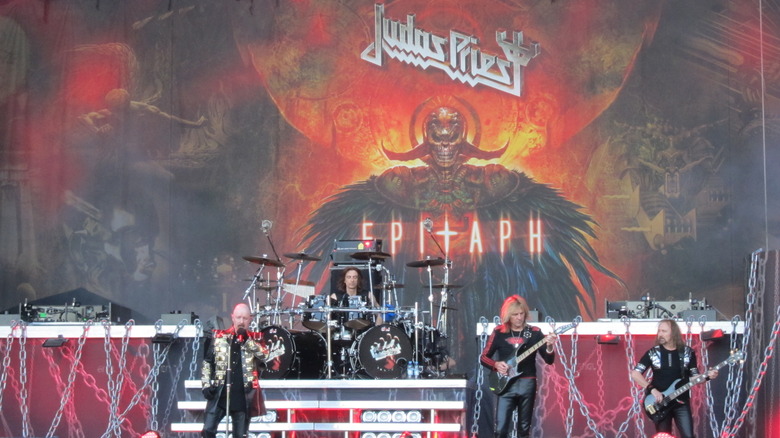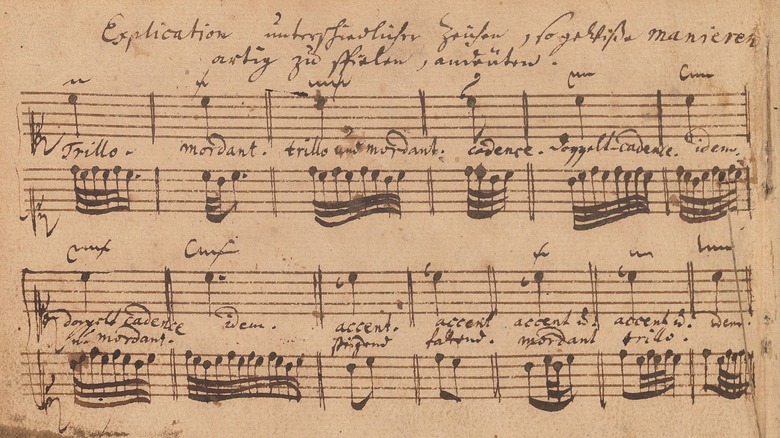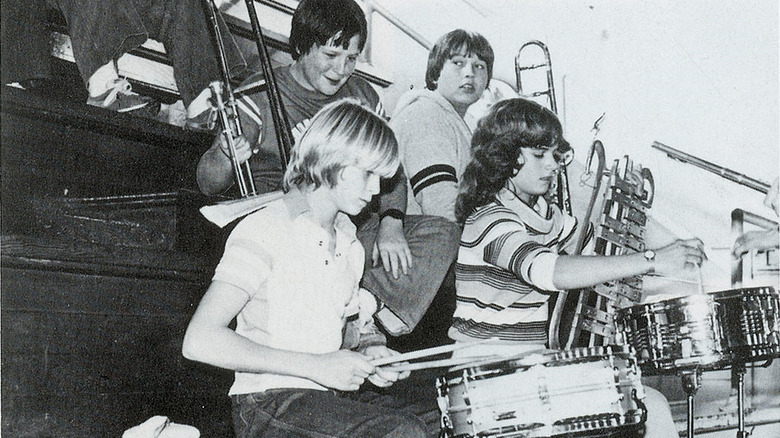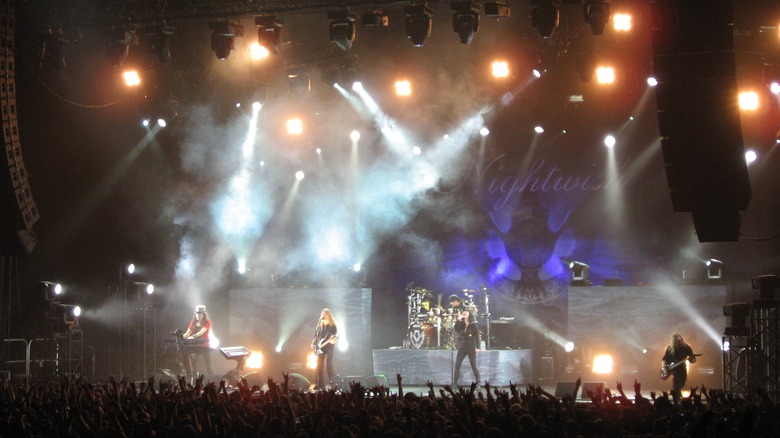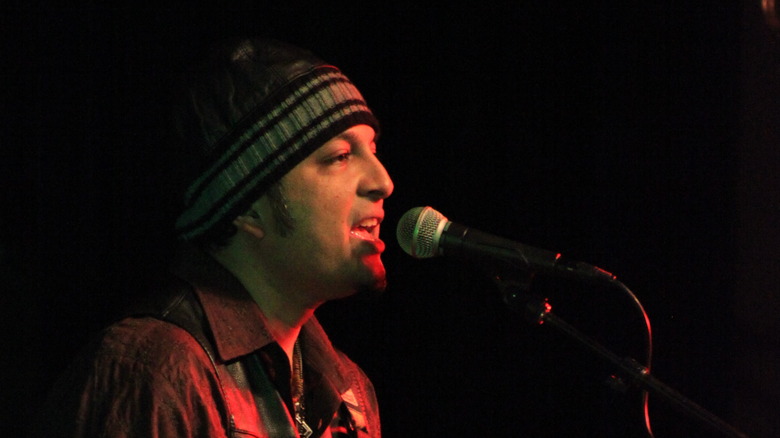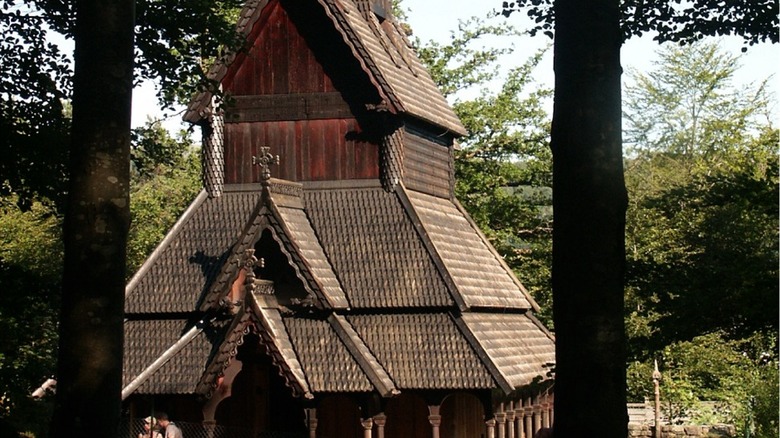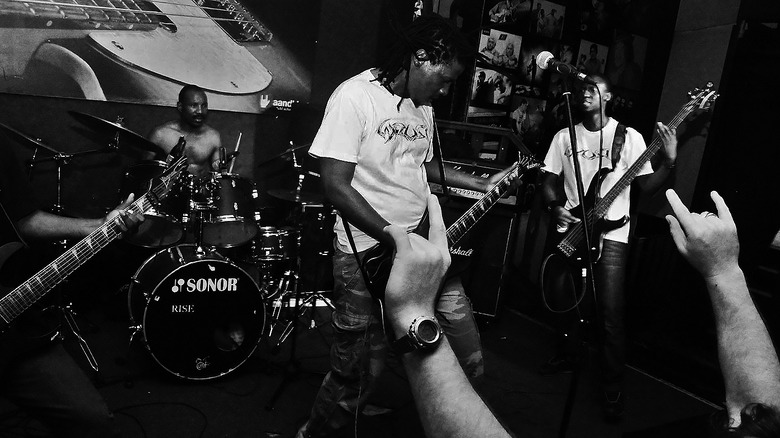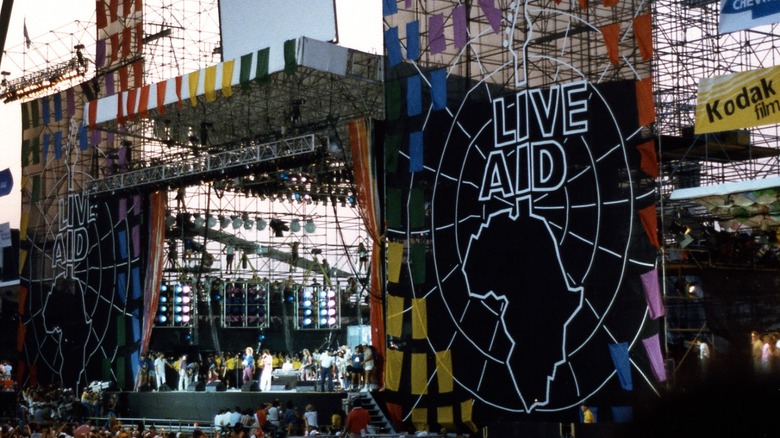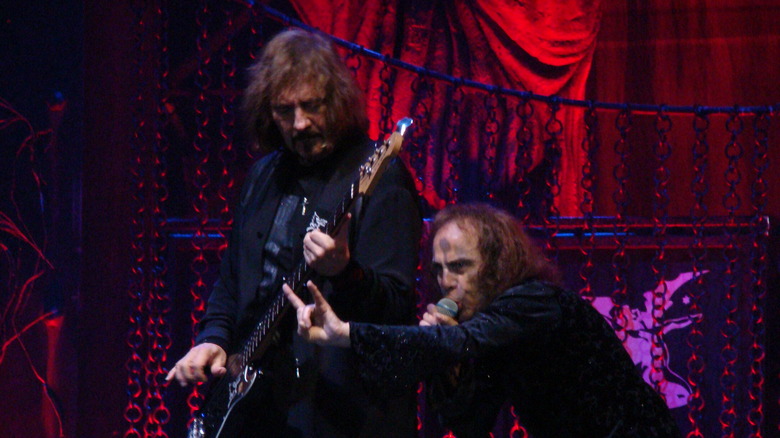The Bizarre History Of Heavy Metal Music
Heavy metal music grew out of blues-rock music. Black Sabbath was one of the major founders of the genre, along with Led Zeppelin and Deep Purple (above), writes Britannica. Leather, studs, and the sign of the horns — often used at concerts — were brought in by different musicians but now comprise fundamental aspects of the heavy metal genre.
Composers and songwriters used chord progressions from the Baroque period, which is why Johann Sebastian Bach actually does have something in common with Black Sabbath. Heavy metal has, however, spawned so many different subgenres that some of them are barely related, despite all being contained to the metal genre.
In the 1990s, Western heavy metal began to slow down, and other countries picked up the slack; as a result, the Scandinavian, African, and Bangladeshi heavy metal scenes are fairly large, if not mainstream. In the 2000s, however, the Western heavy metal scene experiences a rebirth in its underground culture. Let's talk about the bizarre history of heavy metal music.
Black Sabbath needed a name change to really get started
Black Sabbath was one of the founders of the heavy metal genre. Original members Ozzy Osbourne, Tony Iommi, Bill Ward, and Geezer Butler were schoolmates who started a band in the late 1960s rather than start their careers as factory workers in Birmingham, writes Black Sabbath and Britannica. Originally inspired by British blues bands, they started a band called Earth Blues Company before renaming it Black Sabbath. The change came after Butler wrote a song of the same name that got major attention from their fans and was more popular than their other work at the time.
"That's when it all started to happen," Tony Iommi told writer Mick Wall, according to Black Sabbath. "The name sounded mysterious, it gave people something to think about, and it gave us a direction to follow." Black Sabbath grew into one of the major bands of the 1970s and beyond. Their lyrics had plenty of occult symbolism, and even if they weren't beloved by the radio, they were by listeners of this new and interesting genre of music thanks to the band's serious guitar riffs and Osbourne's distinctive vocals.
The fashion of leather and studs was brought in from London's gay club scene
Rob Halford of the heavy metal band Judas Priest brought the fashion of leather and studs into heavy metal in the latter half of the 1970s. The style was borrowed from London's Soho gay club scene and ended up being an indelible aspect of the heavy metal music scene, even if no one knew that it would become so (via MIT). However, the fashion matched the intensity of the music.
As Halford explained in Louder Sound, at the time, he knew he was gay but wasn't sure how to express it. Leather and studs ended up being a new look for the band, a way for them to really look like a heavy metal band, as Halford put it. And luckily for him at the time, none of the fans connected the new look with his being gay, simply finding the band members, Halford included, to be macho and manly.
Composers adopted Baroque chord progressions
Heavy metal composers used chord progressions from the Baroque period in their music, which lasted from the 17th to the 18th century. For example, the guitar solo on Deep Purple's "Highway Star" is similar to Bach's harmonic progressions, writes CBC. "I still listen to a great deal of classical music," Deep Purple member Ritchie Blackmore in a 1985 interview, per a piece in Popular Music. "That's the type of music that moves me because I find it very dramatic. Singers, violinists and organists are generally the musicians I enjoy listening to most of all."
According to Britannica, heavy metal's adaptation of chord progressions, virtuosity, and figuration — not to mention theatrics — from the Baroque period were the most important musical innovations of the 1980s. Guitarists, in particular, exemplified different techniques that showed heavy metal could be as musically complex as other genres; many of this period were influenced by Bach and Vivaldi. For example, Yngwie Malmsteen used diminished seventh chords, phrygian and lydian modes, and harmonic minor scales in his early work, all cribbed from the Baroque masters. Other than two songs with lyrics, the rest of the work on his first album is instrumental pieces to let the music shine all by itself (via CBC).
Academic groups blamed heavy metal for social ills in the 1980s
Academic groups and the international media blamed heavy metal for various social ills in the 1980s, citing everything from suicide to crime (via Britannica). Defenders made sure to note that there was no concrete evidence that heavy metal's themes caused these issues — they simply discussed and explored them. Many band members and fans also considered much of their dark lyrics and themes to be part of the show, according to CNN.
The media easily drew comparisons between violent acts and the music, even though CNN claims evidence actually showed the opposite in the case of the Columbine shooting and heavy metal musician Marilyn Manson. Speaking to the outlet, anthropologist Sam Dunn said of the phenomenon, "I think that it's easy to target a heavy metal band for inciting violence or making kids turn to a cult than it is to actually look at real problems in the real world."
In 1985, Judas Priest was involved in a trial after two young men committed suicide together, citing the band and its subliminal messages of suicide in their work as the reason for their deaths, according to Rolling Stone. One of the men, who did not die but lived with disfiguring injuries for three more years, sued the band over said messages and influences. There was, therefore, some contention as to whether the band was liable for their deaths. Ultimately, the judge ruled that Judas Priest was not accountable for the suicide pact.
If you or anyone you know is having suicidal thoughts, please call the National Suicide Prevention Lifeline at 1-800-273-TALK (8255).
Grunge music replaced the subgenre of hair metal
By the end of the 1980s, the subgenre of hair metal was dying out. Originally popular in the Los Angeles area, hair metal comprised of a simple sound and a theatrical focus. Hair metal bands included Poison and Motley Crue. By the early 1990s, however, grunge music out of Seattle had replaced it completely, writes MIT.
Hair metal was a novelty sound, and additional subgenres such as thrash metal were never popular in the mainstream. As a result, the masses flocked to Seattle's grunge scene instead. Grunge music also stuck with a simplified musical approach but was different from hair metal in nearly every other way (via MIT). Grunge and alternative rock slowly began to take over the airwaves in the 1990s, pushing heavy metal to the side.
According to Far Out Magazine, though it's a cool idea to think that Kurt Cobain of grunge fame killed hair metal simply by dint of his popularity, that simply isn't true. Hair metal was already on its way out, having become a tired shell of itself.
The genre has spawned so many subgenres that some barely relate to each other
Heavy metal has spawned hundreds of subgenres, though there are only a handful of major ones. That said, some subgenres are incredibly different from each other, and music fans can enjoy completely different bands that both still technically count as heavy metal. According to LiveAbout, heavy metal is overall loud and aggressive; however, even in the overall concept, there are substyles, some of which are more melodic than others. For example, gothic metal utilizes a male/female vocal mix, with the female singing in a smooth soprano and the male singer tasked with gutteral vocals.
Guitar Guitar characterizes certain subgenres as mixtures of others, such as death metal being a mix of thrash and black metal. Notably, death metal is heavier on the drums than thrash metal is and changes the vocals into something deeper and heavier. Glam and hair metal are also fairly similar, and due to being so theatrical, they don't fit as well with other heavy metal subgenres (though that view varies from person to person). Power metal and symphonic metal have a stronger focus on storytelling, while symphonic metal adds keyboards and strings. That's fairly different from the epic guitar of Black Sabbath, which shows just how many subgenres heavy metal has and how different they can be from each other.
Bangladeshi heavy metal has an underground scene due to satanic themes
Heavy metal across the world has become known for its satanist themes. This is a particular conundrum for Bangladeshi metal bands, who thrive in the underground scene but don't enjoy mainstream popularity due to their lyrics and themes, writes Roads & Kingdoms.
The capital city of Dhaka has liberal spaces, and the youth underground of those areas have thrived on heavy metal. Often, artists use music as a side gig, with more respectable jobs actually paying the bills (via Roads and Kingdoms). The big question for those from the outside looking in is: How do metalheads from an Islamic nation justify their passion when their religion is against it? Well, that's where the underground scene comes in. These musicians produce their work independently, occasionally playing in towns outside of Dhaka. The genre hasn't caught on much outside of university students and their bands.
Metal band member and Muslim Asif Adnan told Roads and Kingdoms: "The fact that I'm a Muslim doesn't affect the quality of my music. Think of the Indians, for example: Do you believe that their metal is less interesting because they are Hindus? And what about you Europeans? Christianity doesn't make your music better or worse. Metal is a global language, and we Bengalis are proud to add our style to the genre's plate."
Western heavy metal had a rebirth from the underground music scene
In the 1990s, heavy metal languished while grunge and alternative rock took the top spots on the charts in the Western world. But by the time the 2000s came around, original interpretations and subgenres had rebirthed the genre, writes MIT. Since the genre was left alone by the masses over the course of the 1990s, it was given room to innovate and grow. As a result, the heavy metal that emerged in the 2000s was very avant-garde, ranging from symphonic metal with stringed instruments to folk and technical death metal.
The Scandinavian heavy metal scene, in particular, picked up a lot of the slack during the 1990s and early 2000s, with bands like Nightwish, Dimmu Borgir, and Children of Bodom filling that void for a new type of metalhead (via MIT). The relative success of each of these bands is a testament to the fanbase and to the fact that heavy metal was able to reinvent itself in a time of crisis.
Norwegian black metal members were responsible for church burnings
Norwegian black metal emerged in the 1990s, aiming to be more raw than death metal. Black metal was also invented to be a rejection of the then-current death metal scene in Europe and North America. During their heyday, many musicians set fire to more than 50 ornate wooden churches, writes the Daily Hive.
Face-painted musicians led the second wave of black metal, and eventually, the movement centered around Mayhem guitarist Oystein Aarseth's record store Helvete. Aarseth reportedly warned away people who wouldn't understand or enjoy the music. Overall, the scene was mainly made up of young men who were against foreigners, religion, and homosexuality.
In June 1992, Bergen's Fantoft Church burned to the ground in what many initially believed to be an accident. However, over the following months, a growing number of churches were torched and burned. This went on for four years. Out of 45 to 60 church fires from this period, over a third are thought to be perpetrated by black metal band members or fans (per "Lords of Chaos: The Bloody Rise of the Satanic Metal Underground").
Prominent musician Varg Vikernes (born Kristian Vikernes) was thought to have influenced others to commit arson, though he has denied his involvement. However, according to The Independent, he was quoted as saying at his trial: "Through church burning and black metal music, we will reawaken the Norwegians' feelings of belonging to Odin."
Many heavy metal musicians in North Africa are activists
Africa has a strong history of punk and metal bands, even if the continent isn't the first one people think of when they consider strongholds for heavy metal music. Many North African heavy metal band members are activists as well as musicians. For example, Algerian musicians are fighting for the convergence of Berber traditions and black and folk metal, aiming to protect their traditions and history from outside influences by using the music they write (via Invisible Oranges). For example, the Moroccan heavy metal scene is constantly fighting back against a state that considers their work dangerous, while the Kenyan rock band ParkingLotGrass has an EP centered around fighting animal poaching.
In the late 1960s, western punk and psychedelic rock were infiltrating the African airwaves, according to Underground England. The Nigerian Civil War around this same time imbued musicians in this part of the world with lyrics of anger but also ideas for how to rebuild their country. Huck Magazine writes that Botswana's underground heavy metal scene is rife with musicians who are trying to make a difference through music, even if it has a very DIY sound. Giuseppe Sbrana of Botswana metal band Skinflint told Huck Magazine: "What we know for sure is that the founding root, the essence, the magic and ritual that lies at the centre of rock's performative culture — its quest for freedom and destruction as a means of healing and rebuilding — is African. No doubt."
Heavy metal arose from blues rock
The sound of heavy metal came from 1950s blues-rock. Guitarists started experimenting, and drummers began to play louder to be heard over the distorted guitar chords. Bands like The Who and Jeff Beck also began adding feedback into their music (via South China Music Post). Led Zeppelin's first album, released in 1969, was heavy metal mixed with the blues.
The name "heavy metal" was first used by Steppenwolf in 1967 in the LP of the same name with the lyric (via uDiscover Music): "I like smoke and lightnin', heavy metal thunder." Cream, who released their first album in 1966, used rocking instrumentals and sharp moments in the chorus and influenced heavy metal throughout the rest of the 1960s and the 1970s. By 1968, heavy metal experimentation took place in both Britain and North America.
Valve amplifiers were invented in the 1960s and become synonymous with the heavy metal sound of the next few decades. As the 1970s wore on, bands began to leave their blues-rock origins behind, occasionally blending with punk instead and generally speeding up the tempos and adding more drums to their music (via the South China Music Post).
The sign of the horns became ubiquitous at heavy metal concerts
The sign of the horns, after being used by Ronnie James Dio of Black Sabbath starting in 1979, became appropriated by heavy metal fans. It has also now become shorthand for phrases like "Good times" or "Rock on!" Ozzy Osbourne originally began using the peace sign at concerts, and when Dio took over for him in Black Sabbath, he wanted to use a hand sign as well but didn't want to completely copy Osbourne's move (via The Florida Times-Union). Therefore, he found the sign of the horns.
Dio originally borrowed it from his Italian grandmother, who used it as a sign to ward off the evil eye, writes The Florida Times-Union. Other musicians have also used the sign before Dio, including John Lennon. The rock band Coven also used the sign of the horns on their debut LP cover, released in 1969: "Witchcraft Destroys Minds & Reaps Souls." Interestingly enough, the first song on Side A of that LP is called "Black Sabbath." Of course, the band Black Sabbath formed that same year.

